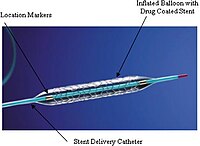
Photo from wikipedia
Background Endovascular thrombectomy (EVT) is the standard-of-care for proximal large vessel occlusion (LVO) stroke. Data on technical and clinical outcomes in distal vessel occlusions (DVOs) remain limited. Methods This was… Click to show full abstract
Background Endovascular thrombectomy (EVT) is the standard-of-care for proximal large vessel occlusion (LVO) stroke. Data on technical and clinical outcomes in distal vessel occlusions (DVOs) remain limited. Methods This was a retrospective study of patients undergoing EVT for stroke at 32 international centers. Patients were divided into LVOs (internal carotid artery/M1/vertebrobasilar), medium vessel occlusions (M2/A1/P1) and isolated DVOs (M3/M4/A2/A3/P2/P3) and categorized by thrombectomy technique. Primary outcome was a good functional outcome (modified Rankin Scale ≤2) at 90 days. Secondary outcomes included recanalization, procedure-time, thrombectomy attempts, hemorrhage, and mortality. Multivariate logistic regressions were used to evaluate the impact of technical variables. Propensity score matching was used to compare outcome in patients with DVO treated with aspiration versus stent retriever Results We included 7477 patients including 213 DVOs. Distal location did not independently predict good functional outcome at 90 days compared with proximal (p=0.467). In distal occlusions, successful recanalization was an independent predictor of good outcome (adjusted odds ratio (aOR) 5.11, p<0.05) irrespective of technique. Younger age, bridging therapy, and lower admission National Institutes of Health Stroke Scale (NIHSS) were also predictors of good outcome. Procedure time ≤1 hour or ≤3 thrombectomy attempts were independent predictors of good outcomes in DVOs irrespective of technique (aOR 4.5 and 2.3, respectively, p<0.05). There were no differences in outcomes in a DVO matched cohort of aspiration versus stent retriever. Rates of hemorrhage and good outcome showed an exponential relationship to procedural metrics, and were more dependent on time in the aspiration group and attempts in the stent retriever group. Conclusions Outcomes following EVT for DVO are comparable to LVO with similar results between techniques. Techniques may exhibit different futility metrics; stent retriever thrombectomy was influenced by attempts whereas aspiration was more dependent on procedure time.
Journal Title: Journal of NeuroInterventional Surgery
Year Published: 2022
Link to full text (if available)
Share on Social Media: Sign Up to like & get
recommendations!